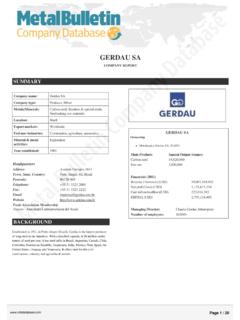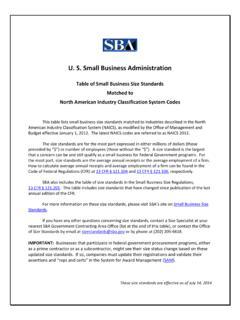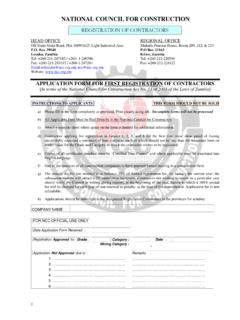Transcription of The Indonesian Nickel Industry – Strategic Market ...
1 Tel: +44 (0) 207 556 6020. Email: Online: The Indonesian Nickel Industry Strategic Market Prospects out to 2020. New&. Exclusive for 2015. The Indonesian Nickel Industry Strategic Market Prospects out to 2020. Table of Contents 1. Indonesian mining law: Following a long-term After 12 January 2014 ..7. Current 2. Indonesian Nickel 11. Refined Nickel 3. Difficulties of investing in 19. Further Types of Nickel investor in 4. Indonesian NPI production development .. 29. Blast Electrical furnaces ..31. Operating Payback period in more 5. Nickel Market dynamics out to 35. 6. Projected projects to 39. Non-NPI NPI 7.
2 Global 53. Will the Nickel recovery happen? ..57. Is this a crisis for the Nickel Industry ? ..57. List of Figures Figure 1: Indonesian GDP (constant $ 2005)..7. Figure 2: Chinese imports of Nickel ore in Figure 3: Japanese imports of Nickel ore in Figure 4: Indonesia: an archipelago full of resources ..12. Figure 5: Indonesian Nickel ore export destinations in Figure 6: Volume export of Nickel ore from Indonesia (WMT)..13. Figure 7: Chinese Nickel ore import sources in Figure 8: Chinese Nickel ore inventories at ports (WMT)..14. See for more information 3. The Indonesian Nickel Industry Strategic Market Prospects out to 2020.
3 List of Figures Figure 9: Indonesian refined Nickel Figure 10: FDI in Indonesia, 2010-2014 ($ billion)..21. Figure 11: Industrial concentration corridors in Master Plan Figure 12: Focus on power supply available in Figure 13: Infrastructure investment in Maluku/Papua to 2025 ($ billion)..26. Figure 14: Infrastructure investment in Sulawesi to 2025 ($ billion)..26. Figure 15: Investor type Figure 16: Capex intensity of blast Figure 17: Capex intensity of electrical Figure 18: Opex per Ni grade/process ($/lb)..32. Figure 19: Payback Figure 20: Total estimated NPI production (Tni), including Figure 21: Nickel production in NPI per Figure 22: Indonesian Nickel capacity/projection, Figure 23: Indonesian Nickel production per product.
4 38. Figure 24: NPI production Figure 25: Global Nickel Figure 26: Nickel production 2014 (left) and Figure 27: Global Nickel production vs consumption to Figure 28: Nickel global supply/demand balance (tonnes Ni)..56. Figure 29: Average LME price range 2013-2020 ($/tonne)..57. List of Tables Table 1: Concentrate export duties Table 2: Nickel content per product allowed to be exported from Table 3: Estimated Indonesian reserves and resources ..12. Table 4: Current Nickel producers in Table 5: Indonesia's investment Table 6: Relative restrictiveness on foreign direct investment, 2014 ..20. Table 7: FDI restrictiveness index for mining & quarrying (including oil extraction) among 58 Table 8: FDI in mining sector in Table 9: Tax incentives available to foreign Table 10: Capital invested in Indonesia and expected to be invested to 2017 (est).
5 28. 4 See for more information 1. Indonesian mining law: Following a long-term plan The Indonesian Nickel Industry Strategic Market Prospects out to 2020. 1. Indonesian mining law: Following a long-term plan metals before exports are fully banned. This sounds disappointing, considering what we said previously of government plans for Indonesia, but Indonesia wants to develop its Industry , not kill it completely; so it is strangling exporters slowly without killing them outright, to force local investment. In exchange, producers must pay export duties (Table 1), which should increase every half-year, and commit to building refining plants.
6 In fact, the mining Ministry has softened its policy by giving an export tax discount (7% instead of 25%. and above) to companies that have showed progress in project development (minimum 30% achieved), but this gift can be taken back easily if there is no more improvement. Most producers complied with the government's requests by paying these taxes and showing development plans, but three years will be too little to build these facilities. We could assume that this period will be extended for projects that can show construction progress, but for those that haven't invested in new plants, permits will be withdrawn.
7 Table 1: Concentrate export duties 2014-2016. 2014 2015 2016. Concentrate H1 H2 H1 H2 H1 H2. Copper 25% 25% 35% 40% 50% 60%. Iron (Hematite) 20% 20% 30% 40% 50% 60%. Iron (Laterite) 20% 20% 30% 40% 50% 60%. Manganese 20% 20% 30% 40% 50% 60%. Lead 20% 20% 30% 40% 50% 60%. Zinc 20% 20% 30% 40% 50% 60%. Ilmenite 20% 20% 30% 40% 50% 60%. Titan 20% 20% 30% 40% 50% 60%. The Contract of Works (CoW) will not be spared and can be cancelled. Vale, for example, is committed to building two new plants, in Bahodopi and Pomalaa, and one extension of the Sorowako plant. If Vale does not comply with the development plan, the risk of government taking out the CoW is real.
8 The question is, does Vale need the CoW? Not really. This agreement is convenient to ensure tax and ore supply stability, but Vale will be free to exploit Nickel ore through IUPs ( mining permits) or to purchase it from different suppliers. On the other hand, Freeport or Newmont cannot yet fully refine their copper production in Indonesia, as Vale can, so their situation is much more delicate if the CoW is cancelled. Moreover, the end of the concentrates export moratorium in December 2016 (after a probable extension of one or two more years) will coincide with the new presidential election in 2019. If he seeks to be re-elected, President Joko Widodo cannot afford to be lenient with foreign investors.
9 Producers that do not comply with the new rules will probably lose their permits, and possibly also lose their concentrate factories, to the profit of a state- owned company. Category 2 exports, which include Nickel and bauxite ore, have been fully banished since 12 January 2014. Why Nickel and bauxite? Bauxite is not a significant mineral in Indonesia exports before the ban were very low in terms of volume, and processing facilities non-existent, so the ban was easy to implement. Nickel is a different story. Some smelters already exist, such as those of Antam or Vale, but the amount of Nickel ore exported was enormous, reaching 64 million tonnes in 2013.
10 Moreover, the sources of Nickel ore are numerous, whereas for copper there are only two or three different actors. Then, Indonesia Nickel ore fed 50-60% of Chinese Nickel ore needs, a country that consumes about 45-50% of the global production of Nickel . Based on these facts, the leak of Nickel ore from Indonesia must be stopped and the potential 8 See for more information The Indonesian Nickel Industry Strategic Market Prospects out to 2020. 2. Indonesian Nickel Industry Indonesia is a very interesting case for investors. The archipelago is a not a big producer of refined Nickel in world terms no more than 98 kilotonnes in 2014 yet it has by far the greatest potential in the coming years regarding refined Nickel production growth and minable reserves.






